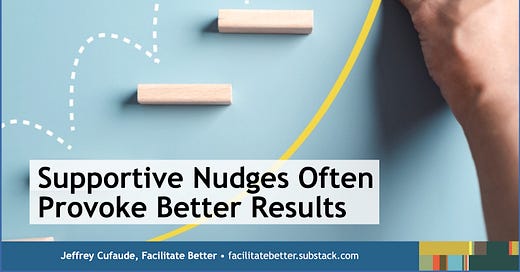Supportive Nudges Often Provoke Better Results (Facilitation Friday #61)
What can happen with a little extra effort may surprise everyone.
“How might you make this even 5% better?”
During a recent facilitation effort, I posed this simple question to a group that, after lengthy discussions, had just selected an idea to implement. Guess what happened next.
In a short period of time, participants generated a few tweaks that likely will yield improved results beyond that 5%.
Nudging or stretching a group to improve upon its efforts is a facilitation choice that doesn’t seem to get much attention. Used judiciously, it is a vital part of challenging and supporting individuals and groups in order to foster growth, progress, and learning.
A facilitator or presenter nudging a group is a milder version of the personal trainer exhorting "just one more rep" when your muscles are fatigued. You may not fully crank it out, but the extra effort will grow your physical (or in my example, mental) muscles.
When individuals and groups push themselves and achieve even a bit more, it can instill residual confidence to call upon in the future. This increased resilience, be it individual or group capacity, is helpful growth.
Nudges To Consider
While just about any discussion or decision can be nudged for better results, I find nudging especially helpful when a group wants to:
reduce costs
increase reach or impact
repurpose and/or reduce “waste”
envision a bold future
broaden support
increase adoption or implementation speed
improve efficiency
simplify and/or streamline efforts
produce a novel or innovative solution
When crafting your nudge or invitation to stretch, remember the value of “how might we (or you)” framing.
Deciding to Nudge
You can always let the group decide for itself if the results reflect their very best effort or if they have “another rep or two” in them. Remember, effective facilitation provides group process leadership while generally operating with restraint.
Instead of offering the nudge yourself, ask participants how they feel about their efforts and if they could/should challenge themselves to do better: “Looking objectively at your decision/choice, what do you think? Is this the best for now?”
Regardless of who ultimately enacts the nudge or the degree of nudging that occurs, be careful the group isn’t pushed too hard or that the “time under tension” goes too long for the participants.
How Big a Nudge?
Let’s explore how to decide with a simple example.
Either seated or standing, raise your arms straight upward and do a good stretch. Now extend your entire upper torso into the stretch as if a trainer is gently pulling your body upwards. Finally, stretch as if a $100,000 check is just out of reach.
Three stretches. Two nudges. If people are standing during this exercise, the last stretch often gets them up on their toes. I’m guessing each nudge increased your stretch to some degree yet neither caused you to shut down and quit.
Think of this experience when you decide to nudge or challenge a group. Whether determined by you or the group, make the first nudge a decent, but doable stretch. If you nudge again, perhaps offer an imagined incentive that might elicit another improved result.
Thinking of going for a big nudge? Use these questions to help assess if that is a preferable choice:
Do participants exhibit the characteristics of a group in the performing stage?
Does the group and/or the environments in which they operate have an achievement-oriented or competitive culture?
Does the group’s choice seem to fall short of what its composition and/or track record suggests participants can produce?
Answering yes to one or more of these questions is usually a green light to challenge the group more significantly.
Nudging Into Action
Decision-making conversations often stall if participants deem the ideas under consideration too risky or if participants struggle to decide on first steps toward a major goal. When this occurs, I draw on these simple nudging questions:
What is the most significant* choice you can commit to right now with little or no reservation?
What’s the most significant* thing you can do tomorrow to start moving toward the stated goal?
Both tend to get participants moving toward an actionable commitment instead of postponing any decision.
*It often is helpful to facilitate a bit of discussion about how participants define “significant” in relation to the ideas, decisions, or goals being discussed.
Bottom Line
Before a group moves on from a decision, consider if nudging them to improve upon it would be desirable. You can invite them to make this call themselves or opt to challenge them based on your sense of their efforts and the session outcomes. If you choose to nudge, do so in a manner that gets participants to budge but provokes no grudge.
Getting in Action
Identify additional situations or outcomes where it might be useful to challenge or stretch a group’s thinking.
Based on what you know about the people and gatherings you facilitate, how might you successfully challenge or nudge their thinking?
Why might (some) participants hesitate or resist being stretched or challenged, regardless of who introduces it? How might you manage that situation?
Bonus Reading
For worthwhile insights and a more comprehensive take on using nudges to influence behavior, check out Nudge: The Final Edition by Richard H. Thaler and Cass R. Sunstein. Below is a PDF summary of some of the book’s core concepts.
© Facilitate Better and Jeffrey Cufaude. All rights reserved.
To affordably license this content for reprint on your site or in electronic or print communications or to contact me regarding customized facilitation skills workshops or consultations, complete this form.





